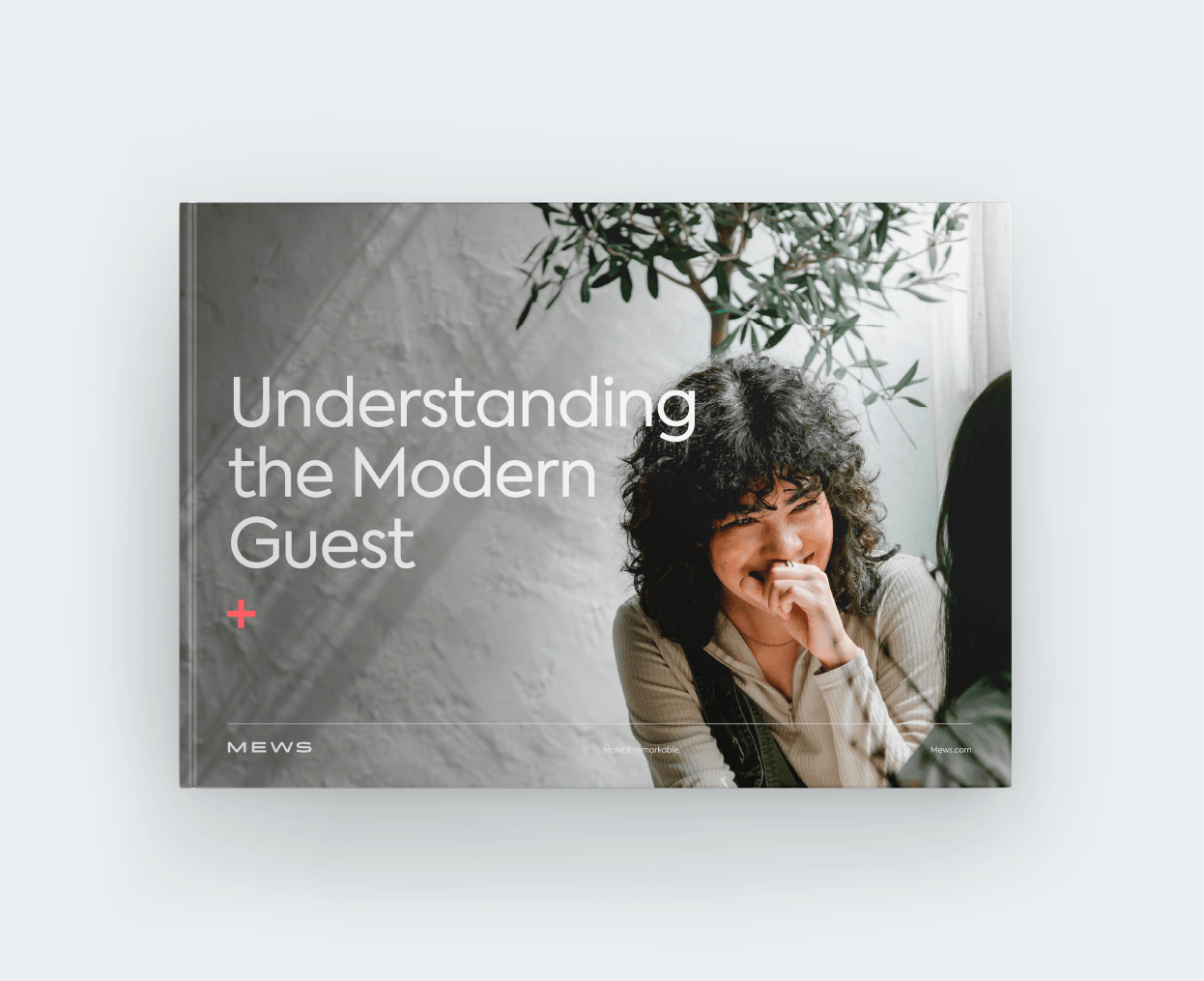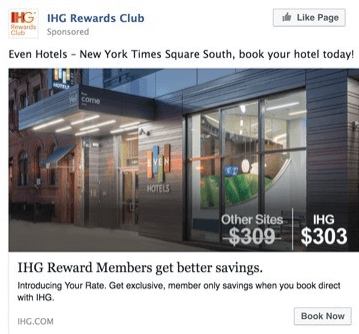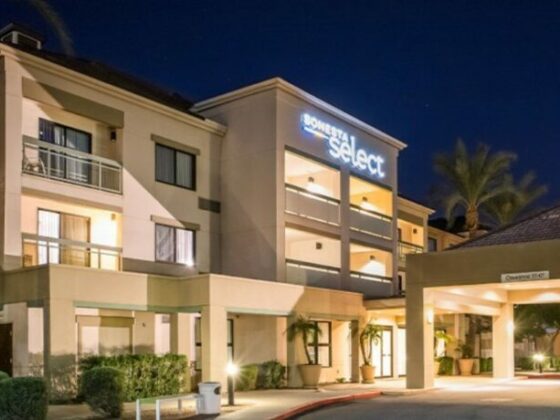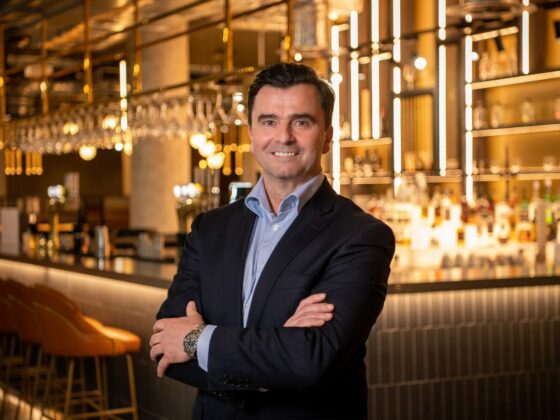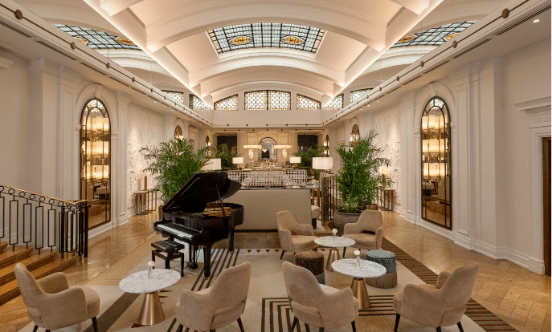What is hotel advertising?
Hotel advertising involves a range of marketing strategies aimed at showcasing your hotel’s services and unique value proposition to increase bookings and drive profitability. These strategies can be both online and offline, including print ads, digital promotions, events, participation in tourism conventions, billboard advertising and more.

Why is advertising important for hotels?
Advertising for hotels is important because it promotes your services and helps turn prospective customers into paying guests. By leveraging different advertising channels, you can highlight your hotel’s unique value proposition at every stage of the funnel.
From building brand awareness during the consideration phase to converting that interest into bookings, these strategies not only boost reservations but also create lasting brand recognition and communicate special offers effectively.
What are the benefits of hotel advertisement?
Now we know why advertising is important for hotels, let’s look at the benefits it can bring.
Create brand awareness
Guests can’t book a stay at your hotel if they don’t know it exists, which is why advertising is essential for building brand awareness and creating buzz. By targeting the right audience at the right time, you’re more likely to convert interest into bookings.
Generate demand
One of the biggest advantages of hotel advertising is demand generation. By showcasing your hotel’s unique location and services, you can position it as “the place to be,” tapping into that fear of missing out (FOMO) to encourage more bookings.
Boost reservations
The more brand awareness you create, the more demand you can generate. The result? When done right, you should see boosted reservations, a higher occupancy rate, and an overall more profitable hotel.
How to create the best hotel advertising strategy?
Follow these five steps to support you in creating the best hotel advertising strategy.
1. Benchmark the competition
Begin by defining your competitive set and benchmarking their strategies. Analyze what they’re doing and how they’re doing it. Identify gaps in the market and craft advertising strategies that leverage your hotel’s unique differentiators to fill those gaps.
2. Define your ICP and buyer personas
Defining your ideal client profile starts with analyzing your current customers, particularly those who are the most profitable. By reviewing guest data and profiles in your Property Management System, you can identify key attributes to help better target your advertisements. Understanding their pain points and how your hotel solves their problems allows you to create more focused, effective ads.
These pain points and client types can then be grouped into buyer personas, enabling you to tailor your ads to each specific audience segment.
3. Determine your budget
Your budget will determine what kind of campaigns you can realistically do. You want to ensure that you invest enough into each type of campaign and have a mix between offline and online material without spreading your budget too thin. Otherwise, you run the risk of not seeing any results at all. It’s also a good idea to create an organic strategy that complements your paid strategy.
4. Choose your channels
As mentioned, it’s essential to diversify your advertising across both online and offline channels. This includes a mix of social media, print, search engine ads, influencer campaigns and offline tactics like billboards or promotional opportunities with the tourism bureau.
5. Refine and repeat
Once you’ve launched your campaigns, check in regularly to see whether the ads are performing according to your key performance metrics. From here, you can tweak as needed, turning off the campaigns that aren’t serving you and investing more in those that are bringing a return. Refining frequently and having a dynamic advertising strategy is key.
Types of hotel advertising and examples
Now that we’ve looked at some of the theory, let’s look at some practical examples.
Print ads are a powerful example of effective offline advertising. When executed well, they can create a lasting impact, especially when strategically placed to reach your target audience. Here are some strategies and examples for crafting successful print ads:
1. Showcase your brand’s identity
Sofitel, a French luxury hotel, launched its “Life is Magnifique” campaign as if it were a handwritten travel journal, showcasing the French elegance and timeless style they embody within their hotels. This approach highlights how your brand’s distinct identity can be creatively expressed to resonate with your target audience.

2. Use imaginative visuals
Westin Hotels & Resorts’ wellness-themed ad uses abstract yet captivating imagery, such as lemons and a parasol, to symbolize relaxation and health. This imaginative design not only catches the eye but also aligns with the brand’s focus on holistic well-being, turning a simple ad into a reflection of their core values.
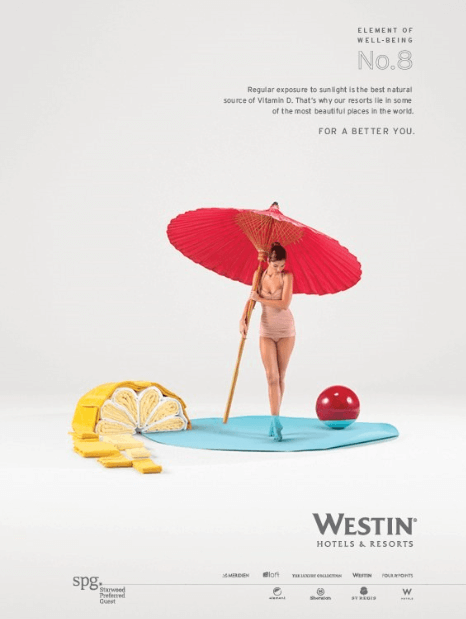
3. Be confident and authoritative
Hilton, as a household name, doesn’t need to establish brand awareness, allowing them to create bold, confident ads. Being direct and assured in your messaging can resonate strongly with audiences when your brand is well-established.
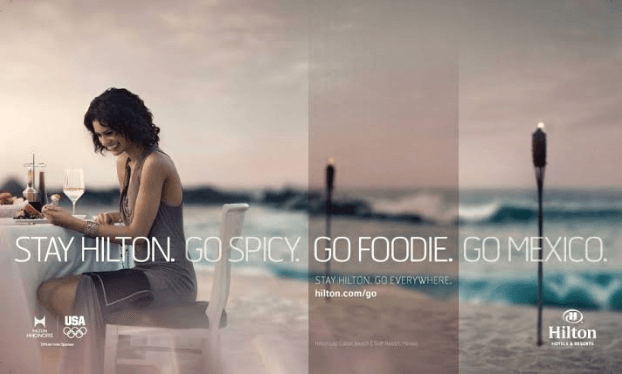
4. Tap into FOMO
Crowne Plaza’s use of tan lines evokes the feeling of missing out on a great vacation. Ads that create emotional triggers like FOMO (Fear of Missing Out) can effectively inspire action and connect emotionally with potential guests.
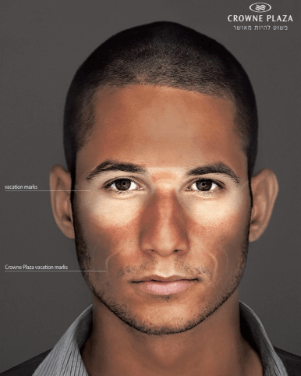
5. Highlight the experience
Rather than just showcasing rooms or facilities, focus on the experiences your guests will have, as Barcelo does with its Caribbean campaigns. Ads that evoke the feelings and emotions tied to the experience can have a stronger impact than highlighting features alone.
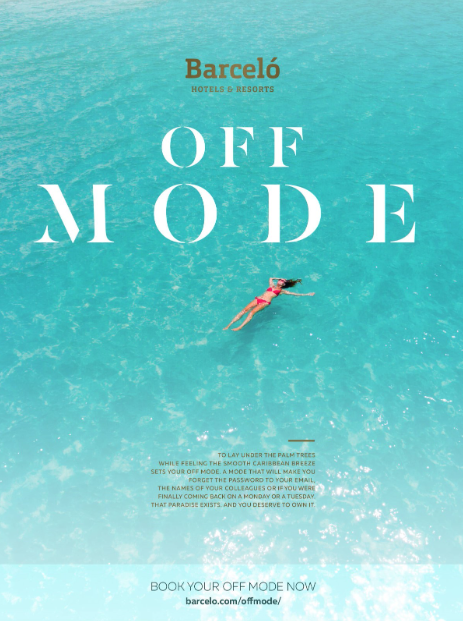
Social media
Social media ads are one of the most effective online advertising strategies for promoting hotels. These campaigns can be directly targeted at your ideal audience, helping you generate demand while staying cost-effective. Your choice of social media platforms, whether YouTube, Facebook, Instagram, LinkedIn, or others, should be tailored to your specific goals and campaign strategy.
1. Appeal to modern travelers on Instagram
Instagram is a dynamic platform where modern travelers can discover and connect with your brand. Hotel Miami effectively engages remote workers — a fast-growing audience — while projecting a fresh, energetic vibe that resonates with younger travelers.
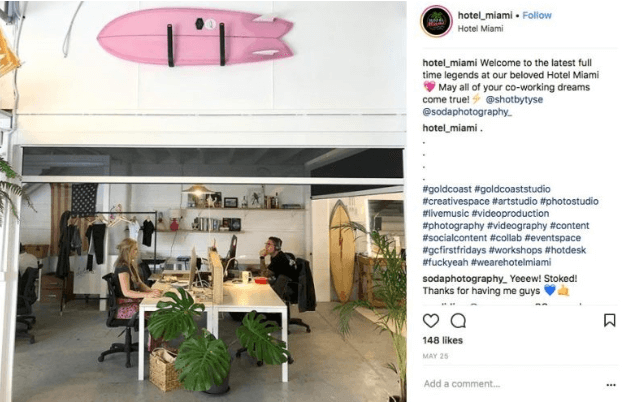
2. Promote loyalty with rewards programs
Social media is perfect for promoting loyalty programs, as IHG Rewards does, by highlighting discounts and benefits. Promoting rewards across channels encourages followers to sign up and engage, helping you build a more loyal community.
3. Collaborate with influencers to expand reach
Influencers are like modern-day billboards on the move, appealing to wide audiences — especially when they align with your target market. For example, Manor House in a small English village amplified its visibility by collaborating with influencer @hercountryliving, reaching her 194K followers and generating thousands of likes.
4. Use storytelling to showcase unique experiences
Social media is an excellent platform for storytelling. The Leela uses Instagram to offer a glimpse into the grandeur and tranquility of staying at their hotels, making potential guests envision their experience.

5. User-generated content
User-generated content builds trust and fosters community by showcasing real experiences from guests. Hyatt excels at this with their branded hashtag #InAHyattWorld, which amplifies guest experiences and gives your brand an authentic touch.
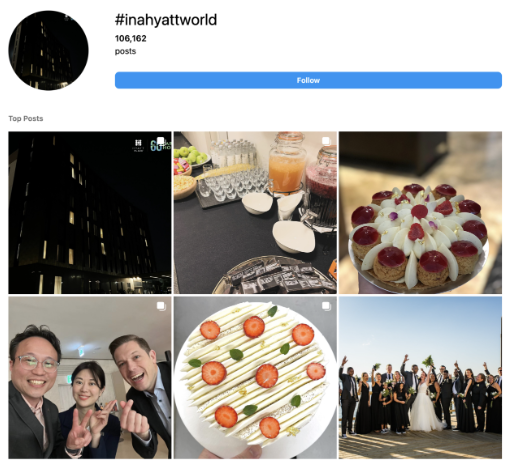
6. Driving lead generation with engaging resources
Offering valuable resources, such as city guides, is a powerful way to generate leads. The Palace Hotel in Bergamo successfully captured guest details by offering a guide, “Insider Travel Secrets,” which attracted potential guests eager to explore the area.
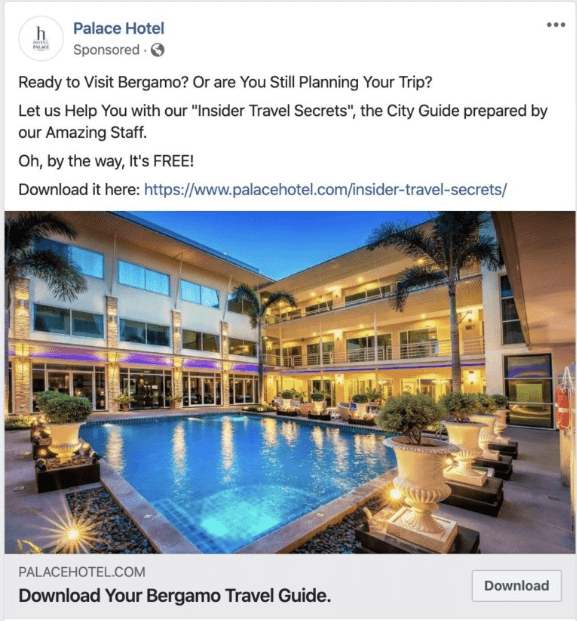
Video
Video ads are a great way to boost your brand because you can get portray more in less time and are likely to captivate your target for a longer time.
1. Showcase your target audience
When crafting a video ad, targeting is essential. Choice Hotels’ “Our business is you” campaign focuses on families, showing a heartwarming glimpse of what their stay could be. It connects on a personal level, helping viewers imagine their own families enjoying the hotel experience.
2. Show don’t tell your hotel’s value proposition
Don’t be afraid to be bold in your video ads. In this stunning ad, the sense of adventure is highlighted through the beautiful sights of India and the luxury of the accommodations. It concludes with the smiling faces of staff members, fostering a genuine human connection.
3. Highlight experiences
YouTube videos are perfect for showing off unique experiences that make your hotel special. In this Four Seasons New Orleans ad, they highlight both their installations and the experience-based marketing that invites guests to imagine themselves there.
4. Show your human side
This ad by Radisson Hotel Dubai Deira Creek gives a glimpse into a day in the life of General Manager Maria Tullberg, highlighting the human side of the hotel business and giving potential guests a look behind the scenes.
5. Showcase your brand’s commitment to social causes
Differentiating your hotel can be as simple as demonstrating a commitment to social and environmental causes. Hilton’s “Travel with Purpose” ad highlights their environmental and social impact, effectively showing their dedication to making a difference.
6. Promote your loyalty program
Video is a powerful tool to market your loyalty program. Marriott Bonvoy Moments does this beautifully by promoting an exclusive yoga experience in a breathtaking location, enticing viewers to sign up for the program.
7. Use influencer partnerships to amplify your reach
Influencers can help extend the reach of your video ads. Meliá Caribe Beach teamed up with the Nitty Gritty Travelers, a YouTube channel with 9.14K subscribers, to showcase a tour of the hotel, reaching a wider audience.
Or consider Sheraton’s approach. The Sheraton Waikiki collaborated with Miriam, a destination specialist and influencer from Yes to Hawaii, who boasts 22.3K followers, to showcase a tour of their facilities. This partnership garnered 26,116 views, bringing the hotel’s offerings to the attention of a wider audience.
8. Spark conversations through creative collaborations
Established brands can keep the spotlight by engaging audiences in unique ways. W Hotels teamed up with rapper Pressa to create a song titled “W Hotel,” blending music and branding to reach a larger, more diverse audience.
Conclusion
In this guide, we’ve explored key strategies for hotel advertising, from identifying your audience to leveraging creative tactics across platforms. By defining your target market and using innovative methods, you can boost visibility, attract new guests, and stand out from the competition.
Download our guide “Understanding the Modern Guest”
